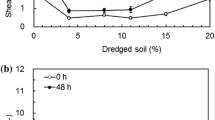Abstract
The desertification of coastal regions is a worldwide problem. It is believed that one of the potential influences is a reduction in the concentration of dissolved iron in seawater. On the other hand, there is a high demand for the use of steelmaking slag generated from iron works. Steelmaking slag concrete, hereafter referred to as SSC, is made from the byproducts of steelmaking, such as steelmaking and ground granulated blast-furnace slags. It has been shown that although SSC releases iron, the dissolved iron is oxidized and precipitates promptly. In the present research, porous-type SSC (POSSC) using hot-metal pretreatment slag (HPS) as an aggregate was manufactured, with the purpose of increasing the amount of iron released from HPS. In addition, the influence of incorporating humus into the paste on the concentration of dissolved iron in artificial seawater and the compressive strength of POSSC was investigated. Two commercially available leaf mulches were used as the humus. The effects of the void ratio and the water-to-binder ratio of the paste were also examined. As a result, it was confirmed that the larger the measured void ratio of the POSSC, the higher the concentration of total iron released by the POSSC. It was also demonstrated that, although a humus fraction of 2% of the volume of the HPS caused an approximately 2 N/mm2 reduction in the compressive strength, the humus clearly stabilized the long-term presence of dissolved iron in the artificial seawater.















Similar content being viewed by others
References
Matsunaga K, Suzuki Y, Kuma K, Kudo I (1994) Diffusion of Fe(II) from an iron propagation cage and its effect on tissue iron and pigments of macroalgae on the cage. J Appl Phycol 6(4):397–403
Matsunaga K, Nishioka J, Kuma K, Toya K, Suzuki Y (1998) Riverine input of bioavailable iron supporting phytoplankton growth in Kesennuma Bay (Japan). Water Res 32(11):3436–3442
Suzuki Y, Kuma K, Kudo I, Matsunaga K (1995) Iron requirement of the brown macroalgae Laminaria japonica, Undaria pinnatifida (Phaeophyta) and the crustose coralline alga Lithophyllum yessoense (Rhodophyta), and their competition in the northern Japan Sea. Phycologia 34(3):201–205
Matsumoto K, Yamamoto M, Sadakata M (2006) Supplying Fe from molten coal ash to revive kelp community. J Chem Eng Jpn 39(2):229–236
Yamamoto M, Fukushima M, Liu D (2012) The effect of humic substances on iron elution in the method of restoration of seaweed beds using steelmaking slag. ISIJ Int 52:1909–1913
Nippon Slag Association (2017) Iron and steel slag statistics. http://www.slg.jp/e/statistics/ Accessed 21 Dec 2017
Matsunaga H, Kogiku F, Takagi M, Tanishiki K (2003) Development of environment-friendly block made of steel slag. Concr J 41(4):47–54 (in Japanese)
Takahashi R, Hamada H (2006) Mechanical characteristics of steel-making slag concrete. Proc Jpn Concr Inst 28(1):1613–1618 (in Japanese)
Park SB, Tia M (2004) An experimental study on the water-purification properties of porous concrete. Cem Concr Res 34(2):177–184
Zhang R, Kanemaru K, Nakazawa T (2015) Purification of river water quality using precast porous concrete products. J Adv Concr Technol 13(3):163–168
Xiang TS, Nakazawa T, Imai F, Onoue K (2010) A study on NOx purification by porous concrete with several kinds of aggregates and void contents. In: Proceedings of the 6th international conference on concrete under severe conditions, CONSEC’10(2), pp 831–838
Park SB, Seo DS, Lee J (2005) Studies on the sound absorption characteristics of porous concrete based on the content of recycled aggregate and target void ratio. Cem Concr Res 35(9):1846–1854
Rose AL, Waite TD (2002) Kinetic model for Fe(II) oxidation in seawater in the absence and presence of natural organic matter. Environ Sci Technol 36(3):433–444
Japan Concrete Institute (2003) Report of the committee on the establishment of design and construction methods of porous concrete (in Japanese)
JIS A 1108 (2006) Method of test for compressive strength of concrete. Japanese Industrial Standards Committee, Tokyo (in Japanese)
Kuma K, Nakabayashi S, Suzuki Y, Matsunaga K (1992) Dissolution rate and solubility of colloidal hydrous ferric oxide in seawater. Mar Chem 38(1–2):133–143
Eugene WR, Rodger BB, Andrew DE, Lenore C (2012) Standard Methods for Examination of Water and Wastewater 2012. American Public Health Association and American Water Works Association and Water Environment Federation
Stooky LL (1970) Ferrozine—a new spectrophotometric reagent for iron. Anal Chem 42(7):779–781
Ross AD (1937) Concrete creep data. Struct Eng 15:314–326
Fisheries Agency (2014) References for designing facilities of fishing ports and fishing areas “15 Fishing reef”. http://www.jfa.maff.go.jp/j/gyoko_gyozyo/g_thema/pdf/dai15hen-2.pdf (in Japanese). Accessed 21 Dec 2017
Acknowledgements
This study was supported by the Japan Society for the Promotion of Science (JSPS) KAKENHI Grant Number JP25740043. The authors also extend their appreciation to Prof. Dr. Yoshihiro Suzuki for his useful suggestions regarding the iron concentration measurements.
Author information
Authors and Affiliations
Corresponding author
Ethics declarations
Conflict of interest
The authors declare that they have no conflict of interest.
Additional information
The contributing editor for this article was João António Labrincha Batista.
Rights and permissions
About this article
Cite this article
Onoue, K., Shimono, S. Iron Supply Capacity of Porous Concrete Using Steelmaking Slag Aggregate for Seaweed Beds or Fish Reef Blocks. J. Sustain. Metall. 4, 333–342 (2018). https://doi.org/10.1007/s40831-018-0174-4
Published:
Issue Date:
DOI: https://doi.org/10.1007/s40831-018-0174-4




